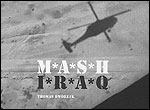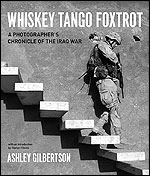These two books—“M*A*S*H I*R*A*Q” and “Whiskey Tango Foxtrot: A Photographer’s Chronicle of the Iraq War”—testify to the collective power of images. Generally, the public only nibbles piecemeal on images sent from Iraq that are published in the daily or weekly press. Within the pages of these books we are presented a full banquet of imagery to dine on. The images of the Iraq War build on one another and consequently take on explanatory powers that words alone are ill equipped to handle.
Even as we take in all of what these photographs tell us about war—the Iraq War, in particular—it is worth noting that the iconic images of this conflict were not taken by professionals. They were taken by amateurs documenting the torture that they were involved with at Abu Ghraib. Their photographs are likely to be what most Americans link in their minds with this war, despite the astonishing record of work by the many professional photographers who have risked their lives, including Thomas Dworzak and Ashley Gilbertson.
Many of the images have not been seen, and they wouldn’t have been if these photographers hadn’t sought to publish these books. As viewers, we glean much from their presentation of these images in groups, as their power reaches us intellectually and emotionally. We learn about the Iraqis and Americans in the images, but we also learn about ourselves as we emotionally connect and react to them. Having this human connection between the viewer and the individuals in a photograph provokes a response rarely achieved by words alone. Images carry dimensions of humanity that are often impossible to verbally describe.
Too often in print media, images are relegated to the second-tier role of mere illustration alongside text or some “color” added to the story. These collections prove again that images can do so much more.
Weaving Words and Images
Both books are about Iraq, yet each provides an entirely different experience for the reader to absorb. Dworzak’s reverie of impressionistic images powerfully evokes the confusion, pain, loss and madness of war experienced on all sides of a conflict; in doing so, it connects the observer with those emotions in real time. The text is reduced to excerpts from the 1970’s CBS television series “M*A*S*H” that are juxtaposed with strong, precisely selected images. The viewer walks step by step, page by page, down the route of disillusionment that Dworzak sets out for us.
His photographs reveal the inner quiet of deep pain felt not only by the patients at the Combat Support Hospital in Iraq, but by the staff who treat them, the buddies who visit them, and ultimately by the Iraqis they’ve encountered in the war. Each image is concise in its message; there are no extraneous images on Dworzak’s pages. Each one carries its weight and contributes profoundly to the group. Through such precision, Dworzak masterfully paints the experience of an occupying force, a force apart from and resented by the people it occupies, and often confused by and resentful of their sentiments.
The concept of interweaving the quotes from the “M*A*S*H” television show and Dworzak’s images from the Iraq War initially struck me as absurd. But its impact turns out to be emotionally powerful to the point of being overwhelming. Using the TV show’s stills and quotes—funny and familiar—and employing that familiarity to connect a Western audience to the contemporary experiences of soldiers on the ground in Iraq makes Dworzak’s experience of the conflict crystal clear. He uses no captions, titles, dates, introduction or postscript, allowing his images to speak with hardly any textual framing. It is a bold move and one that clearly conveys his message regarding the madness, pain and senselessness of war.

An Iraqi man confronts an Iraqi soldier. Photo by Thomas Dworzak/Courtesy of Trolley Books.
Dworzak’s book is rich with detail, and it is an excellent guide for those who have not been there. There is the Iraqi man in gray flannel trousers and a striped short-sleeve shirt over a white undershirt, pen in his pocket, hair well graying and long lines on his unsmiling face, who stands with his heels together, his shoes polished, clutching a newspaper and a half smoked cigarette on an empty street that he shares only with bits of trash, painted over graffiti, and the barrel of a gun pointed at his head by a camouflaged, body armored and helmeted Iraqi army soldier. The man’s powerlessness is clear in the stealing glance he takes at the camera. The moment is laden with the possibility of death. This image is set against two images on the facing page of a Humvee’s bulletproof windshield, cracked where bullets have hit and spattered with blood, as two Iraqis look on, seemingly smiling, and an impressionistic image of the Iraqi army in face masks training through a screen window. The opaque gauze of comprehension—literal in this picture—figuratively describes the shady nature of Iraq’s forces.
There are also the seemingly obligatory images of Americans trying to let off steam as they escape the hour-after-hour pressure of serving in Iraq. Stogies come out on a night and elicit smug smiles from men in Army T-shirts. A young man takes an awkward backward plunge into a pool by a destroyed Saddam palace while flashing victory (or is it peace?) signs with both of his hands.
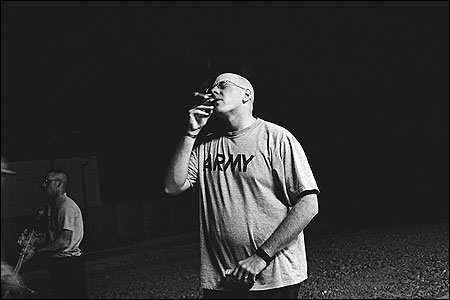
A soldier relaxes with a stogy. Photo by Thomas Dworzak/Courtesy of Trolley Books.
Dworzak offers a concluding meditation on how different individuals in the military respond to war. Some think it “stinks,” in the words of Hawkeye Pierce (played by Alan Alda in “M*A*S*H”), while some thrive on it. But all must contemplate it and its impact on them and others.
The final image is a striking but unexplained one of an Iraqi youth whose head has been torn apart, likely by high caliber gunfire. An older Iraqi gentleman, well dressed but in a shirt stained with blood, stands to the side. Is this his son dead on the ground? An Iraqi policeman plaintively gestures for the man to tell them something about the dead youth. Another Iraqi stares into the nothingness before him. To the left are three uniformed members of the coalition, standing over the body as one American, his flag clearly visible on his uniform’s sleeve, makes a video of the dead youth lying in the street. Are they this youth’s killers?
Are we, as photojournalists, mere voyeurs in our recording of death? Dworzak asks himself this question and presents his work as the answer. When images are compiled as they are in “M*A*S*H I*R*A*Q,” photojournalists not only document what they see, but provide an essential emotional level of understanding about this war that viewers would otherwise be without.
Meshing Personal and Professional Perspectives
In “Whiskey Tango Foxtrot,” Gilbertson provides a personal, illustrated narrative of his own professional coming of age in Iraq as a war photographer. His accompanying text is articulate and revealing, and his images are edited to compliment and illustrate his story. As a consequence, images that would never have been put into a book of photographs meant solely as a visual record of Iraq appear in this one. Nevertheless, Gilbertson has created a memorable documentation of his experience in Iraq, showing us people he worked with and soldiers he came to know. As he does this, we come to appreciate how what he witnessed in Iraq gradually destroyed his innocence about war—and about this war, in particular.
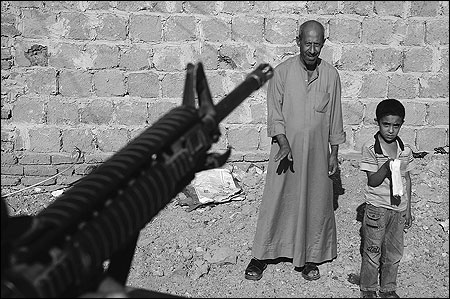
In Samarra, a man and his son venture outside to see the damage to their neighborhood. Photo courtesy of Ashley Gilbertson/University of Chicago Press.
Gilbertson’s is an incredibly rich journal revealing the personal, professional and emotional challenges for a professional photographer in a war zone. Words fill the first 20 pages of this book before a single image is reached. Gilbertson’s words are well worth absorbing, not because they usher forth an Iraq that most Americans don’t know but because they offer an impressive psychological portrait of what it’s like to cover war. After witnessing the fighting in Fallujah in November 2004, Gilbertson discovers his underlying hope for the American project in Iraq that he had unconsciously held during his work there. He also discovers how his innocence, illustrated by that hope, is torn to shreds by his experiences working there.
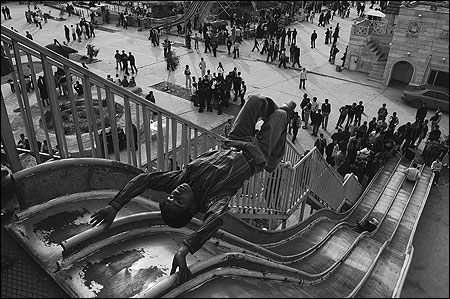
A boy plays on the slide at al-Zawraa park in Baghdad. Before entering the park, he was searched for weapons and a suicide vest, just as other children as young as five were. Photo courtesy of Ashley Gilbertson/University of Chicago Press.
It’s somewhat baffling that Gilbertson tells his incredible story about working in Iraq without seeming to contemplate—or at least not that he reveals on these pages—the hell that Iraqis endured, too. It is most certainly a horrific hell to spend hours in a windowless Marine outhouse to file pictures, but Gilbertson’s is a temporary hell. What of the Iraqis and the permanent and painful changes to their lives that they endure as their homes and neighborhoods are destroyed, their lives and livelihoods shattered, loved ones killed or maimed, and their families broken?
“Whiskey Tango Foxtrot” is about Gilbertson and his stories from a war-torn place. It is not a deliberate exploration of the emotions of war, which is what photography books from such conflict areas often are. Perhaps that is a loss, but in spite of that it is still a remarkable record of Gilbertson’s journey and well worth the read for that alone.
Molly Bingham, a 2005 Nieman Fellow, is director, with Steve Connors, of “Meeting Resistance,” a documentary film about the emergence and development of the Iraqi insurgency, as told through the voices of seven men and one woman actively involved in the fight. More information about the film can be found at www.meetingresistance.com.
Even as we take in all of what these photographs tell us about war—the Iraq War, in particular—it is worth noting that the iconic images of this conflict were not taken by professionals. They were taken by amateurs documenting the torture that they were involved with at Abu Ghraib. Their photographs are likely to be what most Americans link in their minds with this war, despite the astonishing record of work by the many professional photographers who have risked their lives, including Thomas Dworzak and Ashley Gilbertson.
Many of the images have not been seen, and they wouldn’t have been if these photographers hadn’t sought to publish these books. As viewers, we glean much from their presentation of these images in groups, as their power reaches us intellectually and emotionally. We learn about the Iraqis and Americans in the images, but we also learn about ourselves as we emotionally connect and react to them. Having this human connection between the viewer and the individuals in a photograph provokes a response rarely achieved by words alone. Images carry dimensions of humanity that are often impossible to verbally describe.
Too often in print media, images are relegated to the second-tier role of mere illustration alongside text or some “color” added to the story. These collections prove again that images can do so much more.
Weaving Words and Images
Both books are about Iraq, yet each provides an entirely different experience for the reader to absorb. Dworzak’s reverie of impressionistic images powerfully evokes the confusion, pain, loss and madness of war experienced on all sides of a conflict; in doing so, it connects the observer with those emotions in real time. The text is reduced to excerpts from the 1970’s CBS television series “M*A*S*H” that are juxtaposed with strong, precisely selected images. The viewer walks step by step, page by page, down the route of disillusionment that Dworzak sets out for us.
His photographs reveal the inner quiet of deep pain felt not only by the patients at the Combat Support Hospital in Iraq, but by the staff who treat them, the buddies who visit them, and ultimately by the Iraqis they’ve encountered in the war. Each image is concise in its message; there are no extraneous images on Dworzak’s pages. Each one carries its weight and contributes profoundly to the group. Through such precision, Dworzak masterfully paints the experience of an occupying force, a force apart from and resented by the people it occupies, and often confused by and resentful of their sentiments.
The concept of interweaving the quotes from the “M*A*S*H” television show and Dworzak’s images from the Iraq War initially struck me as absurd. But its impact turns out to be emotionally powerful to the point of being overwhelming. Using the TV show’s stills and quotes—funny and familiar—and employing that familiarity to connect a Western audience to the contemporary experiences of soldiers on the ground in Iraq makes Dworzak’s experience of the conflict crystal clear. He uses no captions, titles, dates, introduction or postscript, allowing his images to speak with hardly any textual framing. It is a bold move and one that clearly conveys his message regarding the madness, pain and senselessness of war.

An Iraqi man confronts an Iraqi soldier. Photo by Thomas Dworzak/Courtesy of Trolley Books.
Dworzak’s book is rich with detail, and it is an excellent guide for those who have not been there. There is the Iraqi man in gray flannel trousers and a striped short-sleeve shirt over a white undershirt, pen in his pocket, hair well graying and long lines on his unsmiling face, who stands with his heels together, his shoes polished, clutching a newspaper and a half smoked cigarette on an empty street that he shares only with bits of trash, painted over graffiti, and the barrel of a gun pointed at his head by a camouflaged, body armored and helmeted Iraqi army soldier. The man’s powerlessness is clear in the stealing glance he takes at the camera. The moment is laden with the possibility of death. This image is set against two images on the facing page of a Humvee’s bulletproof windshield, cracked where bullets have hit and spattered with blood, as two Iraqis look on, seemingly smiling, and an impressionistic image of the Iraqi army in face masks training through a screen window. The opaque gauze of comprehension—literal in this picture—figuratively describes the shady nature of Iraq’s forces.
There are also the seemingly obligatory images of Americans trying to let off steam as they escape the hour-after-hour pressure of serving in Iraq. Stogies come out on a night and elicit smug smiles from men in Army T-shirts. A young man takes an awkward backward plunge into a pool by a destroyed Saddam palace while flashing victory (or is it peace?) signs with both of his hands.

A soldier relaxes with a stogy. Photo by Thomas Dworzak/Courtesy of Trolley Books.
Dworzak offers a concluding meditation on how different individuals in the military respond to war. Some think it “stinks,” in the words of Hawkeye Pierce (played by Alan Alda in “M*A*S*H”), while some thrive on it. But all must contemplate it and its impact on them and others.
The final image is a striking but unexplained one of an Iraqi youth whose head has been torn apart, likely by high caliber gunfire. An older Iraqi gentleman, well dressed but in a shirt stained with blood, stands to the side. Is this his son dead on the ground? An Iraqi policeman plaintively gestures for the man to tell them something about the dead youth. Another Iraqi stares into the nothingness before him. To the left are three uniformed members of the coalition, standing over the body as one American, his flag clearly visible on his uniform’s sleeve, makes a video of the dead youth lying in the street. Are they this youth’s killers?
Are we, as photojournalists, mere voyeurs in our recording of death? Dworzak asks himself this question and presents his work as the answer. When images are compiled as they are in “M*A*S*H I*R*A*Q,” photojournalists not only document what they see, but provide an essential emotional level of understanding about this war that viewers would otherwise be without.
Meshing Personal and Professional Perspectives
In “Whiskey Tango Foxtrot,” Gilbertson provides a personal, illustrated narrative of his own professional coming of age in Iraq as a war photographer. His accompanying text is articulate and revealing, and his images are edited to compliment and illustrate his story. As a consequence, images that would never have been put into a book of photographs meant solely as a visual record of Iraq appear in this one. Nevertheless, Gilbertson has created a memorable documentation of his experience in Iraq, showing us people he worked with and soldiers he came to know. As he does this, we come to appreciate how what he witnessed in Iraq gradually destroyed his innocence about war—and about this war, in particular.

In Samarra, a man and his son venture outside to see the damage to their neighborhood. Photo courtesy of Ashley Gilbertson/University of Chicago Press.
Gilbertson’s is an incredibly rich journal revealing the personal, professional and emotional challenges for a professional photographer in a war zone. Words fill the first 20 pages of this book before a single image is reached. Gilbertson’s words are well worth absorbing, not because they usher forth an Iraq that most Americans don’t know but because they offer an impressive psychological portrait of what it’s like to cover war. After witnessing the fighting in Fallujah in November 2004, Gilbertson discovers his underlying hope for the American project in Iraq that he had unconsciously held during his work there. He also discovers how his innocence, illustrated by that hope, is torn to shreds by his experiences working there.

A boy plays on the slide at al-Zawraa park in Baghdad. Before entering the park, he was searched for weapons and a suicide vest, just as other children as young as five were. Photo courtesy of Ashley Gilbertson/University of Chicago Press.
It’s somewhat baffling that Gilbertson tells his incredible story about working in Iraq without seeming to contemplate—or at least not that he reveals on these pages—the hell that Iraqis endured, too. It is most certainly a horrific hell to spend hours in a windowless Marine outhouse to file pictures, but Gilbertson’s is a temporary hell. What of the Iraqis and the permanent and painful changes to their lives that they endure as their homes and neighborhoods are destroyed, their lives and livelihoods shattered, loved ones killed or maimed, and their families broken?
“Whiskey Tango Foxtrot” is about Gilbertson and his stories from a war-torn place. It is not a deliberate exploration of the emotions of war, which is what photography books from such conflict areas often are. Perhaps that is a loss, but in spite of that it is still a remarkable record of Gilbertson’s journey and well worth the read for that alone.
Molly Bingham, a 2005 Nieman Fellow, is director, with Steve Connors, of “Meeting Resistance,” a documentary film about the emergence and development of the Iraqi insurgency, as told through the voices of seven men and one woman actively involved in the fight. More information about the film can be found at www.meetingresistance.com.

